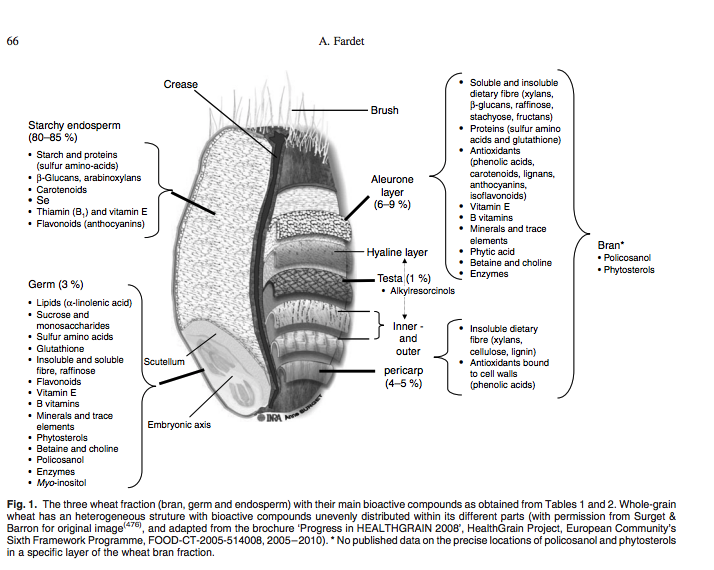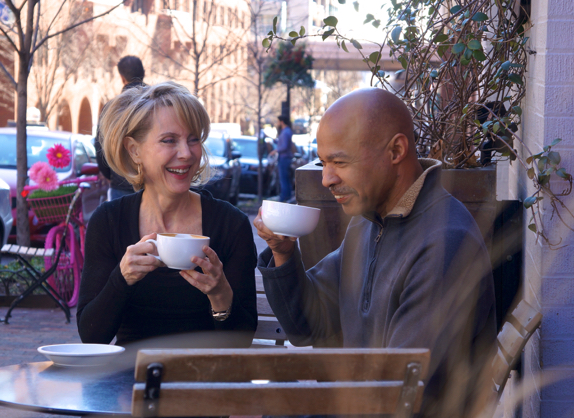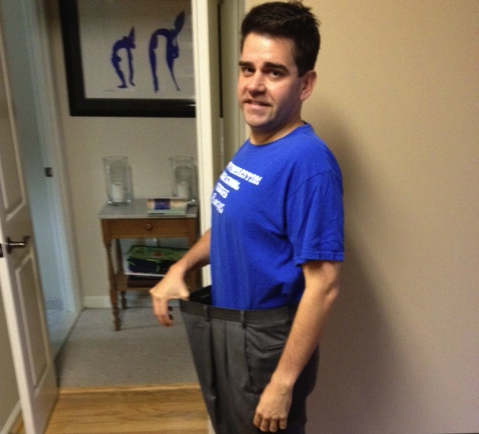Trying to Lose Weight? Skip the Diet Soda and Go To The Tap!
- At November 13, 2015
- By Katherine
- In Articles, News
 0
0
People trying to lose weight look for any way to cut calories. We tend to consume a lot of calories in liquid form, so people often think diet beverages are a great way to help them lose weight. But researchers have a better (and cheaper!) solution: good old fashioned water.
In a recent American Journal of Clinical Nutrition study, participants on a weight-loss plan were asked to cut out diet drinks in favor of water after lunch over 24 weeks. Compared to those who stuck with diet soda, those who drank H2O saw greater weight loss and better insulin resistance.
Water is cheaper than diet beverages and is great for digestion. So if you’re looking to improve your health and slim down, skip the can and head for the tap! Your stomach will thank you.
Reason? This study I’ve written about shows artificial sweeteners may reduce your ability to burn body fat, but there may be other reasons, too…
Your Weight Affects Arthritis Flare-Ups and Remissions
- At November 11, 2015
- By Katherine
- In Articles, News
 0
0

Your size affects whether rheumatoid arthritis, a painful and debilitating form of arthritis, flares up or goes into remission. A recent study looked at whether Body Mass Index (BMI) – your weight – had any relationship with rates of long-tern remission of early rheumatoid arthritis (ERA). They looked at patients in the normal (BMI 18.5-24.9), overweight (25-29.9), and obese (≥30) ranges.
Results showed that rheumatoid arthritis sufferers who are at healthy weights were able to stay in remission longer than people in the overweight and obese ranges, who were less likely to achieve long-term remission.
What does that all mean? Your body weight (BMI) isn’t the final word in health, but it shows that weight control and management might play a part in rheumatoid arthritis treatment.
Up Your Orange Intake! Doses of Vitamin C Shown to Effectively Eliminate Cancer Cells
- At November 10, 2015
- By Katherine
- In Articles, News
 0
0
Researchers have studied the effects of Vitamin C, most famously found in oranges, for some time, but results have been mixed. Some studies showed success while others did not, though some of the discrepancy may be explained by how the Vitamin C was administered; injections worked while oral consumption did not.
A recently published study builds on these past findings and might explain the results. Researchers found that Vitamin C is most effective in an oxidized form, meaning it has been combined with oxygen. They specifically found that high doses of oxidized Vitamin C killed mutated colorectal cells. The treatment slowed tumor growth in mice and, in one result, “dramatically changed” the metabolic profile of the mutated cells within just one hour of treatment.
The most exciting part, though? Oxidized Vitamin C has “selective toxicity”, meaning the treatments killed off cancer cells without harming normal cells.
The study was done on mice, so future steps would have to include human testing to make sure the results carry over, but the outcomes are promising and would be a major breakthrough in cancer treatment. Regardless, I’m using these findings as an excuse to add more delicious oranges to my diet!
co-authored by Nik Nartowicz
A Gluten-Free Reality Check
- At August 17, 2015
- By Katherine
- In Articles, News
 0
0
 A whopping 21 percent of Americans are currently making an active attempt to eat gluten-free, according to a Gallup poll published July 23. That dwarfs the 1 percent of the U.S. population diagnosed with celiac disease, the only medical condition that requires gluten-free products for someone with the disease to live a healthy life.
A whopping 21 percent of Americans are currently making an active attempt to eat gluten-free, according to a Gallup poll published July 23. That dwarfs the 1 percent of the U.S. population diagnosed with celiac disease, the only medical condition that requires gluten-free products for someone with the disease to live a healthy life.
More and more Americans are on the anti-wheat warpath trend, as the label “gluten free” appears on everything from craft beer to cat food. For those with celiac disease, a life-threatening autoimmune disorder that destroys the gastrointestinal tract, going gluten-free is critical to avoid damage to the small intestine. For everyone else, though, it is an unnecessary, and – potentially unhealthy, diet.
The gluten-free industry
Such facts haven’t stopped the food industry from taking advantage of the trend, and gluten-free products have grown to represent a $9 billion market in 2014, according to the Burdock Group, which specializes in food market research, among other issues.
Gluten-free foods, especially refined foods processed to make them gluten-free (many made with potato starch or rice starch), cheat the consumer out of the many health benefits of whole grains — such as wheat, barley and rye — and can be seriously lacking in critical nutrients such as fiber iron, zinc, folate, niacin, thiamine, riboflavin, calcium, vitamin B12, phosphorus, fiber and iron.
A whole grain contains all three parts of a grain: the bran, germ and endosperm, as opposed to a refined grain which only contains the endosperm. The nutritional riches are mostly found in the bran and the germ. Decades of research, conducted predominantly on gluten-containing whole wheat, according to Joanne Slavin a professor in the department of food science and nutrition at the University of Minnesota in St. Paul, has found that people who eat whole grains, containing all three parts of the grain, are less likely to be overweight or have diabetes, heart disease or even many cancers, including colorectal cancer, and head and neck cancer in women.
“Whole grain cereals can protect the body against the increased oxidative stress that is involved and/or associated with all the major chronic diseases: metabolic syndrome, obesity, diabetes, cancers, and cardiovascular disease,” according to a comprehensive review in Nutrition Research Reviews. “Whole-grain cereals are good sources of antioxidants (thirty-one compounds or groups of compounds are listed picture above). Some specific mechanisms are today well recognized. For example, food structure influences satiety and the slow release of sugars recommended for type 2 diabetes. Dietary fiber improves gut health, and the antioxidant and anti-inflammatory properties of most phytochemicals can help prevent cancer and cardiovascular disease.
The U.S. Dietary Guidelines Advisory Committee, a group of scientists convened to offer nutrition recommendations for Americans to the federal government, said dietary patterns of the American public are suboptimal and are causally related to poor individual and population health and higher chronic disease rates.” The scientists recommended diets higher in fruits, vegetables, and whole grains than is currently consumed.
“Across all ages and both sexes, the US population does not meet the goal for whole grain intake, The inadequate intake of whole grains leads to underconsumption of several … nutrients of public health concern. “
Most gluten-free processed foods are not made with nutrient-rich, health-protecting whole grains. Furthermore, the gluten-free label has very little to do with the nutritional value of a food. French fries, and many candies, for example, are naturally gluten-free.
People without celiac disease who follow a gluten-free diet (many of whom aren’t even aware of what gluten is or what contains gluten, according to a hilarious recent Jimmy Kimmel piece) have been known to cite numerous reasons for doing so. A common one is a feeling of lethargy or ill health that has come to be associated with eating gluten. However, the feeling of wellness that many attribute to the removal of gluten from their diets is more likely due to the absence of the refined carb- and sugar-laden snacks and desserts that happen to contain the protein (so why not simply remove those foods but keep the healthy gluten-containing foods?).
If you are concerned that you may have celiac disease, you should have your doctor, preferably a gastroenterologist, perform an intestinal biopsy — and you shouldn’t cut gluten until you know for sure that you need to.
Celiac disease cannot be self-diagnosed, and a patient must be eating gluten for the disorder to be properly identified. Until then, you should treat the gluten-free trend as any other fad diet: Don’t get sucked in by the hype.
Bountiful Berries
There are very few foods that match the beautiful color and intense flavor of berries. And, fortunately, these fruits are nutrition superstars.
For many years, most berries were regarded as nutritionally inferior because of their lack of traditional essential nutrients such as vitamins A and C. But that was before scientists recently discovered the presence of large amounts of beneficial phytochemicals (“phyto” is Greek for plant).
Apparently, each berry contains at least 100 nutrients and phytochemicals, the plant compounds with potent powers of healing. Some of the most important phytochemicals in berries are antioxidants, powerful substances believed to reduce inflammation, improve immune function and help prevent heart disease and cancers.
Antioxidants are compounds that absorb oxygen free radicals — molecules that cause oxidation in the body’s cells. Scientists believe that these molecules cause most of the diseases of aging, such as immune system decline, arthritis, heart disease, cancer and neurological impairments affecting cognition and balance. Think of oxidation as being similar to rusting. Or imagine an apple slice turning brown. By simply adding lemon juice, an antioxidant, the apple’s flesh stays fresh and prevents the browning or oxidation.
A similar thing happens in your body. Oxidation is constantly occurring in your cells because of environmental pollutants, smoking, exposure to the sun, heat generated through basic metabolic functioning, unhealthy diets and other factors. It takes a large supply of antioxidants to counter this. Berries have been found to have one of the highest antioxidant scores of all fruits and vegetables.
But there are other good reasons to eat berries. The berry family contains 300 to 400 beneficial, disease-fighting chemicals. The phytochemicals in berries, depending on the type, also stimulate the immune system, reduce inflammation, enhance cancer-fighting enzymes, positively influence hormone metabolism, have antibacterial and antiviral effects and may even reverse some aspects of brain aging.
The most potent berries are the more deeply colored varieties, especially blackberries, blueberries and cranberries, followed by raspberries, strawberries and cherries (not technically a berry, but similar nutritionally) but all more potent than most other fruits. Their color (blue/purple) is provided by one of the most powerful phytochemicals, called anthocyanins, which berries synthesize to protect themselves from the elements.
Anthocyanins, a type of polyphenol (polyphenols are also found in other fruits and vegetables), reduce inflammation, according to a 2015 article in the American Journal of Clinical Nutrition, which plays a role in protecting against cancers, heart disease, and other chronic diseases. They may also play a role in preventing risk of Alzheimers and Parkinson’s Diseases, according to many years of animal research published in a 2014 article in Neural Regeneration Research.
Cranberries, may be responsible for helping to prevent urinary tract infections, stomach ulcers, gum disease and even ear infections in children. Cranberries are also effective against antibiotic-resistant bacteria — and 20 percent of urinary tract infections are resistant to antibiotics. The phytochemicals in cranberries work by blocking the disease-causing bacteria and preventing it from adhering to human cell walls.
“There is strong experimental evidence that cranberry bioactives have favorable effects on blood pressure, glucose metabolism, lipoprotein profiles, oxidative stress, inflammation, and endothelial (the lining of blood vessels),” said Jeffrey Bloomberg, et al, in the journal, Advances in Nutrition. But all berries have strong health benefits.
A study published in 2014 in the Journal of Nutrition found a reduction in insulin resistance, especially with Anthocyanins (found in abundance in berries). According to the study, these benefits can be “found with intakes readily achieved in the diet.” They may even improve bone density in women, according to a study published in 2012 in the Journal of Bone Mineral Research and a 2014 article in Osteoporosis International. This may be caused by their antioxidant and anti-inflammatory properties, which may help prevent bone breakdown.
A study published in Neurology in 2012 found a high flavonoids diet (found in berries among other fruits and vegetables) was correlated with a reduction in the incidence of Parkinson’s Disease in men.
Resveratrol
New research has found that raspberries, blueberries, cranberries and huckleberries contain a phytochemical called resveratrol, also present in wine, which is thought to help prevent cancer, cardiovascular disease, and is implicated as an important compound for health.
Strawberries contain large amounts of phytochemicals called ellagitannins, which are also in raspberries and blackberries. Studies at the UCLA Center for Human Nutrition found those berries are capable of inhibiting a number of key steps in the development of cardiovascular disease and may have immense potential for the prevention and treatment of heart disease and stroke. Strawberries are also high in antioxidant Vitamin C and folic acid, important in preventing birth defects.
“Strawberries contain a variety of bioactive compounds that can promote longevity and quality of life. For humans, these compounds can act as antioxidants, serve as anti-inflammatory agents, improve cell to cell communication, cause cancer cells to die, detoxify carcinogens — a number of benefits consistent with health and disease risk reduction.” said Dr. Burton-Freeman at an American Academy of Nutrition and Dietetics conference.
While most of what scientists know about berries has been determined in animal studies and in labs using cell cultures, new human studies are showing promising results.
Berries are an ideal food. Besides being absolutely delicious and colorful on a plate, they’re loaded with nutrients, vitamins, minerals, fiber, and they’re low in calories. They have maximum flavor and nutrient content when picked at ripeness. Freezing them when ripe or buying ripe frozen berries is a great alternative. But, simply ripening a berry on your kitchen counter will increase its phytochemical content, too.
Berries can be eaten morning, noon or night – whatever your preference. I eat berries every morning on my oatmeal. In the summer, I’ll use any fresh local berry but in the winter, I stick with frozen blueberries.
“Berries are extremely versatile; they fit perfectly with any meal or snack,” says Janie Hibler, author of “The Berry Bible” (William Morrow, 2004). In “The Berry Bible,” Hibler provides a berry encyclopedia and berry recipes ranging from smoothies, drinks, and breads to soups, salads, salsas, main courses, and desserts.
So, what are some ways we can eat berries every day?
“A no-brainer,” she says, “is a berry smoothie for breakfast.” For lunch, she says, throw a handful into your salad. For snacks, carry dried berries and nuts. At dinner, berries go beautifully with meats, grains and main courses.
You will eat more berries if you simply keep them on hand and ready to grab. Get them now when they’re fresh and freeze them yourself. Frozen blueberries are fun snacks for kids to pop in their mouths, like hard candy. You can also make berry popcicles, syrups for pancakes and spritzers.
Berry Coulis
Hibler recommends always having berry purees, or “coulis” on hand. “A sauce rivaled by none,” she says. But they also are great added to drinks, smoothies, yogurts, cereal, you name it.
To make a coulis, rinse and drain the berries, process in a food processor. Add a little sugar or even liqueur, if desired. It will keep in your refrigerator for three to four days or be frozen for a month.
Some of my favorite berry recipes:
Spinach and Strawberry Salad with Toasted Almonds and Balsamic Vinaigrette
Katherine’s Spicy Mexican Salsa with Strawberries
Soupe aux Fraises et Rhubarbe (Strawberry Rhubarb Soup)
Kjerstin’s Curried Chicken Salad with Strawberries and Toasted Almonds
Burning Body Fat with Coffee: 9 Tips for Your Fitness & Health
- At March 22, 2015
- By Katherine
- In Articles, News
 0
0
You’ve heard about coffee’s benefits. But have you heard them all? What about its fat-burning potential? Earl Williams, owner of Georgetown’s Definitions Personal Trainers’ Gym, interviews Katherine Tallmadge (me), about coffee, the scientific facts about its health and fitness benefits, and 9 tips for how you can make coffee work for you.
Earl: I developed Metabolic Resistance Training (MRT) to help clients optimize fat burn and I’m always looking for other ways to complement this. What are the benefits of drinking coffee for those who exercise with the goal of fat loss?
Katherine: The caffeine in coffee enhances physical performance. “Caffeine may act directly on muscle to enhance its capacity to exercise,” according to “Essentials of Exercise Physiology,” by William D. McArdle and Frank L. Katch. It facilitates the use of fat as fuel for exercise, thus sparing the body’s limited glycogen reserves, according to McArdle and Katch. “Coffee can be a positive part of a sports diet if a person chooses to drink a cup of coffee before they work out,” said Nancy Clark, author of Sports Nutrition Guidebook. Coffee / caffeine also increases metabolism causing the body to burn more calories, according to a study published in the American Journal of Clinical Nutrition (1).
Earl: Coffee drinkers commonly add sugar, artificial sweeteners, milk, syrups, etc. How do these additives affect the benefits of drinking coffee?
Katherine: Most of them add calories. So, keep in mind that one syrupy, high calorie drink (some as high as 500 calories — 1⁄4 of one day’s calorie needs) can make the difference between losing and not losing weight. That said, a Latte or Cappuccino are especially good to drink, not only because of the caffeine, but also because of the protein, carbohydrate, potassium and other nutrients contained in the milk.
Earl: Is there a window of time before, during, or after the workout that coffee should be consumed?
Katherine: “People have different sensitivities and reactions to caffeine,” said Clark. But, “peak concentration is within 30 and 120 minutes after ingestion to exert an influence on the nervous, cardiovascular and muscular systems,” according to McArdle and Katch.
Earl: Any guidance on the daily amount consumed?
Katherine: That would be personalized and depend on a person’s tolerance level of coffee/caffeine. But “drinking the amount of caffeine (330 mg*) in 2.5 cups of coffee one hour before exercising significantly extends endurance in intense aerobic exercise,” according to McArdle and Katch. Which means you can exercise longer before feeling its effects, thus increasing endurance.
Earl: Caffeine in coffee helps mobilize fat in tissues and the bloodstream making the fatty acids available as fuel for exercise—thus sparing and making accessible—muscle and liver glycogen for performance. What are fatty acids?
Katherine: Fat, called triglycerides, partly comes from food and ends up in the bloodstream. When you exercise regularly (every 24 hours), fat/triglycerides are sent into the muscles where it is burned as fuel. If you do not exercise often enough, the triglycerides stay in the bloodstream causing obesity, high bad (LDL) cholesterol and high blood triglycerides – all associated with an increased risk of heart disease.
Earl: The fitness community once thought coffee was a diuretic and could not provide the hydration water could. Is this still the case?
Katherine: Coffee and tea are now considered good hydrators, according to the most recent scientific analysis and report by the National Academy of Science’s Food and Nutrition Board (2).
Earl: Under what circumstances should coffee be avoided?
Katherine: You should ask your doctor if you should avoid or limit coffee, especially if you have high blood pressure or are pregnant.
Earl: What are some of the other health benefits of drinking coffee?
Katherine: The research is promising. Some recent studies suggest that coffee may be associated with a reduced incidence of all causes of death and cardiovascular disease (3), of Type 2 Diabetes (4), Parkinson’s Disease (5), Alzheimer’s (6), Multiple Sclerosis (7), liver cancer(8) – the second leading cause of cancer deaths world-wide – and perhaps other health conditions. Of course, though exciting, the research is just in its beginning stages. More controlled human clinical studies are needed to learn more specifics as to why and how coffee may or may not work to improve your health.
Earl: Any other thoughts about coffee?
Katherine: It is important that the exerciser test the effect of different levels of coffee/caffeine on their performance several times to determine the ideal amount and achieve the best level of performance before any major competition or long term bout of exercise.
(8) World Cancer Research Fund International’s Continuous Update Project (CUP)
Do It Now! New Year’s Resolutions Really Work
- At January 05, 2015
- By Katherine
- In Articles, News
 0
0
The GOOD news: According to the author of a study published in the Journal of Clinical Psychology, “You are ten times more likely to change by making a New Year’s resolution.” The study showed that 50 percent of people who seized the New Year as an opportunity for change met their goals.
The BAD news: It’s not that simple. There are some basic steps you need to follow to turn a wish for change into reality. Here’s what the study shows will work:
7 Steps to Making Your New Year’s Resolution Stick
1. Set Your Positive Long Term Goal. Have an exciting vision of yourself having achieved your goal. See yourself – how you look and feel – crossing a goal line, as professional athletes do; envision how great you’ll look in those upcoming wedding photos; see your doctor congratulating you for your success
2. Develop a Specific Action Plan for the Year. “In one year I will achieve a 50-pound weight loss.” Develop a sense of urgency about your goal by pondering the negative consequences of not making your goal, “How would it feel to be the same weight next year?”
3. Break up your Goal into Bite-Size Pieces. It’s more gratifying to achieve your goals every day or every week. For instance, instead of thinking about your year’s goal, say, “I will lose 1 pound per week,” or “daily I will eat fruit and/or veggie snacks.” Again, ponder the consequences of your actions, “Should I roll back into bed instead of getting up to exercise? Do I want to feel good today – or do I want to feel crummy today?”
4. Reward yourself for your Successes. The latest research finds financial rewards can be very successful. But daily pats on the back are important, too.
5. Don’t Make a Backup Plan, as you are less likely to work toward your main goal and may more readily accept failure
6. Develop Genuine Confidence. It’s a potent predictor of who succeeds.
7. Expect Occasional Slips. Studies of successful weight losers show they experience similar stressors and slips as relapsers, they just react differently to them: They pick themselves up, dust themselves off and start all over again.
The battle of the bulge is won at the margins. Sweeping dietary overhauls are impractical and don’t work over time. Shrewd, small, concrete, positive changes which can be easily incorporated into your daily routine lead to success.
What’s More Damaging: Sugar? or Artificial Sweeteners?
- At October 08, 2014
- By Katherine
- In Articles, News
 1
1
Katherine’s 5 Tips are at the end of the article…
For years, my clients have asked me, “Is it better to eat ‘sugar-free’ yogurt? Or, yogurt with fruit on the bottom with all that sugar? What about sugar in my coffee? Sugar-sweetened beverages, like soft drinks?” My answer has alway been, to my clients’ surprise, “A little sugar won’t hurt. Eat the yogurt you enjoy the most, even if there’s a little jam at the bottom! And a teaspoon of sugar in your coffee shouldn’t do any harm.” New scientific research may prove my moderate approach has been right all along.
Artificially sweetened beverages and foods are seen as guilt-free pleasures, because they are lower in calories – or even zero calories – compared to other similar foods. You may think of them as a great choice when you’re trying to lose weight or trying to keep blood sugar in check. But some surprising new research suggests that artificial sweeteners might actually do the opposite, “by changing the microbes living in our intestines [1],” according to experts at The National Institutes of Health.*
To explore the impact of various kinds of sweeteners on the zillions of microbes living in the human intestine (referred to as the gut microbiome), an Israeli research team first turned to mice. One group of mice was given water that contained one of two natural sugars: glucose or sucrose; the other group received water that contained one of three artificial sweeteners: saccharin (the main ingredient in Sweet’N Low®), sucralose (Splenda®), or aspartame (Equal®, Nutrasweet®). Both groups ate a diet of normal mouse chow.
To their surprise, the researchers discovered that many animals in the artificial sweetener groups—especially those that drank saccharin-sweetened water—developed a condition called glucose intolerance, which is characterized by high blood glucose levels and is an early warning sign of increased risk for developing type 2 diabetes. In contrast, the animals that drank sugar water remained healthy.
The result was puzzling. These mice weren’t consuming natural sugars, so what was raising their blood glucose levels? The researchers had a hunch that the answer might lie in the gut microbiome—since those microbes play a vital role in digestion. Their suspicions were borne out. When they used DNA sequencing to analyze the artificial sweetener group’s gut microbiome, they found a distinctly different collection of microbes than in the animals drinking sugar water.
The next step was to distinguish whether these changes in the microbiome resulted from high blood glucose, or caused it. When the researchers used antibiotics to wipe out the artificial sweetener group’s gut microbes, their blood glucose levels returned to normal—evidence that the gut microbes were actively causing glucose intolerance. Additional proof came from experiments in which the researchers transplanted microbes from both groups of mice into the intestines of a mouse strain that had been raised in a sterile environment from birth. The germ-free mice that received microbes from the artificial sweetener group developed glucose intolerance; those getting microbes from the sugar group did not.
But what about humans?
The research team examined clinical data from 400 people taking part in an ongoing nutrition study. That analysis showed that, compared to people who didn’t use artificial sweeteners, long-term users of artificial sweeteners tended to have higher blood glucose levels and other parameters often associated with metabolic diseases like diabetes, obesity, and fatty liver.
Next, the researchers asked seven healthy human volunteers, who had never previously consumed foods or beverages containing artificial sweeteners, to consume the daily maximum dose of saccharin allowed by the U.S. Food and Drug Administration for six consecutive days. Of the seven volunteers, four developed glucose intolerance, while three maintained normal blood glucose regulation. The researchers then took intestinal microbes from human volunteers and transplanted them into germ-free mice. Microbes from humans with glucose intolerance also triggered glucose intolerance in the mice, while microbes from humans with normal blood glucose had no effect.
Previous studies have associated changes in the gut microbiome with obesity and diabetes in humans [2, 3, 4]. But the latest findings, which still must be confirmed in larger studies and by other groups, advance our knowledge one step further by suggesting that artificial sweeteners may be one of what’s likely to be an array of factors with the power to shape such changes. Who knows what the next piece of that fascinating puzzle might be?
Katherine’s 5 Tips
- Use artificial sweeteners with caution,
- Just a spoonful of sugar/jam/honey can’t hurt – maximum 10% of your calorie needs – for example, if you need 1,500 calories per day, enjoy 150 calories worth of sweets per day,
- As usual, moderation is key. If you have trouble eating too many sweets, find out why and click for strategies,
- Eat plenty of yogurt, which contains natural probiotics, to populate your gastrointestinal tract with healthy microbes (they may help reduce body fat and insulin resistance),
- Eat plenty of high fiber foods, considered “prebiotics,” which increase the effectiveness of the probiotics, helping your gastrointestinal tract stay healthy,
- If you have an interest in learning more about sugar substitutes, take a look at the Center for Science and Public Interest’s “Sweet Nothings: Safe or Scary… The Inside Scoop on Sugar Substitutes.”
References:
[1] Artificial sweeteners induce glucose intolerance by altering the gut microbiota. Suez J, Korem T, Zeevi D, Zilberman-Schapira G, Thaiss CA, Maza O, Israeli D, Zmora N, Gilad S, Weinberger A, Kuperman Y, Harmelin A, Kolodkin-Gal I, Shapiro H, Halpern Z, Segal E, Elinav E. Nature. 2014 Sep 17.
[2] Microbial ecology: human gut microbes associated with obesity. Ley RE, Turnbaugh PJ, Klein S, Gordon JI. Nature. 2006 Dec 21;444(7122):1022-3.
[3] A metagenome-wide association study of gut microbiota in type 2 diabetes. Qin J, Li Y, Cai Z, Li S, Zhu J, Zhang F, Liang S, Zhang W, Guan Y, Shen D, Peng Y, Zhang D, Jie Z, Wu W, Qin Y, Xue W, Li J, Han L, Lu D, Wu P, Dai Y, Sun X, Li Z, Tang A, Zhong S, Li X, Chen W, Xu R, Wang M, Feng Q, Gong M, Yu J, Zhang Y, Zhang M, Hansen T, Sanchez G, Raes J, Falony G, Okuda S, Almeida M, LeChatelier E, Renault P, Pons N, Batto JM, Zhang Z, Chen H, Yang R, Zheng W, Li S, Yang H, Wang J, Ehrlich SD, Nielsen R, Pedersen O, Kristiansen K, Wang J. Nature. 2012 Oct 4;490(7418):55-60.
[4] Gut metagenome in European women with normal, impaired and diabetic glucose control.Karlsson FH, Tremaroli V, Nookaew I, Bergström G, Behre CJ, Fagerberg B, Nielsen J, Bäckhed F. Nature. 2013 Jun 6;498(7452):99-103.
*The article above is from the National Institutes of Health
Photo by www.sugar.org
Two Large Meals (Breakfast & Lunch) are Best at Controlling Weight
- At May 21, 2014
- By Katherine
- In Articles, News
 2
2
- Mark Indre began eating a larger breakfast and a lighter dinner… “I have lost more than 35 pounds and have kept it off for more than two years with Katherine’s Diet Simple program.”
A new study confirmed what I’ve suspected for the twenty (or more) years I’ve been a diet counselor. Eating hearty meals earlier in the day instead of in the evening leads to weight loss and better health, even when the same foods and same calories are eaten.
A recent study published in the scientific journal, “Diabetologia,” found people with Type 2 Diabetes eating a large breakfast and lunch – and no dinner, as compared with those eating six small meals with the same calories – lost more body fat, liver fat, and improved insulin sensitivity.
That’s not to say you shouldn’t be eating dinner, as scientists often exaggerate conditions to get measurable results in their studies. But you can likely use the study’s conclusions to make positive changes for your health and weight, as did my client, Mark Indre.
“I lost more than 35 pounds and have kept it off for more than two years,” said Mark Indre.
Some points to consider…
Does this sound familiar? You get home from work, stressed and ravenous. You head straight for the kitchen, grab a bowl of nuts or a plate of cheese and crackers. You nibble as you’re preparing dinner. After dinner, you settle on the couch, most likely in front of the television, and zone out with some favorite snacks, such as popcorn, chips, nuts, ice cream, peanut butter or sweets—whatever is tasty and easy to grab.
Welcome to the typical American evening! For many people, it’s an endless graze that doesn’t stop until they go to bed.
Evening overeating is an issue that contributes to many peoples’ weight problems. I’ve been surprised at just how many people struggle with this. I used to myself. Even disciplined people who carefully watch their intake during the day break down at night. I can’t count how many times I’ve heard these refrains: “I’m fine during the day, my problem’s at night,” or “If I could control my eating at night, my weight problem would probably disappear…. ”
This is important because more and more research is confirming the importance of eating lighter at night and heavier during the day – for health, not just weight. A recent study published in “Diabetologia” found people who at a large breakfast and lunch – and no dinner, as compared with people with type 2 diabetes who ate 6 small meals – lost body fat and improved insulin sensitivity. This occurred while eating the same calories, just distributed differently.
It’s become clear to me that evening overeating is not just an isolated problem but the convergence of a host of lifestyle issues—stress, exhaustion, loneliness, disorganized eating and hunger.
In today’s fast-paced world, many people are constantly hopping from meeting to meeting or from chore to chore during the day and don’t have time to sit down and eat a decent meal. So we become ravenous. In the evening, there’s more time for eating, so we not only eat larger meals, but continuous ones. Those who are tired or stressed find that food is an easy way to reward themselves at the end of the day. Food can provide a little companionship for the lonely or depressed. Researchers who have identified “night eating syndrome,” the most severe form of evening overeating that affects about five percent of obese people seeking treatment, say it is stress-related.
“We believe it’s a stress disorder which causes people to eat more than one-third of their calories after the evening meal,” says obesity researcher Albert J. Stunkard, who has studied nighttime overeaters since the 1950s and recently co-authored “Overcoming Night Eating Syndrome: A Step-by-Step Guide to Breaking the Cycle” (New Harbinger Publications, 2004).
Evening overeating is an important problem to solve because Americans who eat most of their daily intake of food at night eat more overall calories, according to a study reported in the Journal of Nutrition. And that makes them more susceptible to weight problems.
“The late-night period was when the highest-density foods were eaten. Eating a high proportion of daily intake in the late evening, compared to earlier in the day, was associated with higher overall intake,” researcher John M. de Castro concluded in the study, which analyzed food diaries of about 900 men and women.
De Castro, professor and chair of the department of psychology at the University of Texas at El Paso, also found that evening eating was less satisfying for people, which may help explain why they eat more.
“In the evening, you get lower satiety. People tend to eat very large meals but then eat again shortly afterward,” said de Castro.
For those who succumb to nighttime overeating, I recommend you attack this problem by assessing why this may be happening to you and then devising specific personalized strategies for eating lighter at night. Some points to consider:
Breakfast: De Castro’s study found that a “high proportional intake in the morning is associated with low overall daily intake.” This finding confirms my experience of 25+ years: Eating a bigger breakfast is the single most effective way of curbing evening overeating. Other studies have confirmed the importance of breakfast for maintaining weight loss.
I advise my clients to eat one-third of their daily calories in the morning. For most people, that’s at least 600 calories, much more than they’re used to consuming.
While solving other issues such as end-of-day stress, exhaustion and emotional issues are important, too, I’ve found that nothing works unless morning eating is beefed up first. Eating more in the morning is a scary proposition for many people who fear that they’ll continue their evening overeating on top of the bigger breakfast. But my clients who bite the bullet and give it a try are amazed to find that it reduces cravings and gives them a sense of control, so that it is easier to eat more moderately later in the day.
Interestingly, de Castro found that people are more sated with the food they eat in the morning. “If they eat a large breakfast, they’ll wait a long time before eating again. They get a lot of bang for the buck,” says de Castro.
Organized eating: Researchers have found that most people with the more severe “night-eating syndrome” don’t have regular meal and snack times. I have also found this is true for evening overeaters. Most overeating is due simply to undereating throughout the day and poor planning. I hear so many people say “I have no will power,” or “I hate myself because I have no discipline.” But they somehow regain their “discipline” and “will power” by simply planning and eating regular daytime meals and snacks.
That’s why I advocate cooking in large batches and regular grocery shopping so that you have healthy and delicious foods at your fingertips when you get home from work in the evenings.
Trigger foods: Many people who overeat in the evenings have “trigger” foods, specific foods they crave and are more likely to overeat, such as chips, chocolate or peanut butter. The experts find the avoidance of trigger foods can reduce evening overeating.
Assessing hunger: Your body lets you know what it needs. One key to lasting weight management is being in touch with your body and its signals. In the evening, before eating, get rid of distractions, take a few deep breaths and stop to think if you’re physically hungry. If you’re hungry, eat. If you’re not, or if you’re not sure, you shouldn’t eat.
Stress management: Many people overeat in the evenings as a way to cope with the stress and exhaustion they may feel or to reward themselves at the end of a hard day. But this is a self-defeating response to stress or rewards. When you come home, never head straight for the kitchen. Instead, hop in the shower or tub to decompress, take a walk or stretch. Once relaxed, then decide what you’d like for dinner. Better yet, hopefully you’ve already planned your dinner.
Of course, these actions are only possible if you’ve fed yourself properly during the day and you’re not ravenous.
Reducing behavioral associations: Like Russian scientist Ivan Pavlov’s famous dogs, we can train ourselves to salivate and crave food in connection with just about any activity. Playing cards, eat. Watching a movie, eat. Going to the mall, eat. Talking on the phone, eat. Reading in bed, eat. Watching TV, eat. The experts recommend you eat only when seated at your dining or kitchen table, without distractions, so that you don’t develop an association between eating and any activity, place or person. The only stimulus for eating should be hunger. Distractions tend to reduce inhibitions to overeating.
When to eat: There is no hard-and-fast rule governing the timing of your last meal in the evening. I recommend that evening calories don’t exceed lunch or breakfast calories and that you eat at least two-thirds of your day’s calories before dinner. It’s important to go to bed feeling light, not full. This way, you awake hungry for a big breakfast.
Tired of Blizzard Bloat? Reversing Winter Weight Gain
- At February 24, 2014
- By Katherine
- In Articles, News
 0
0
Have you noticed your weight creeping up this winter? Are you experiencing more cravings than usual, especially for heartier, more fattening foods? Well, take heart. You’re not the only one experiencing “blizzard bloat,” the creeping up of body fat hitting a large number of people during the winter months.
In the animal kingdom, fattening up in winter is critical for survival. Animals overeat to store enough excess fat to survive until spring. The human animal has a similar natural instinct, probably leftover from the days when food was scarce in winter and shivering in the cold caused us to burn our fat stores too quickly, leaving us too thin to survive (aaaah, those were the days!). But now, with temperature control, improved agricultural techniques and a cupcake shop on every corner, that leftover but highly frivolous instinct just causes trouble. Because of modern conveniences, we humans fatten up following the old instincts when we no longer need to!
Though these old instincts are plausible as a cause of winter weight gain, there are more complex—and controllable—causes too. The most important probably involve decreases in both sunlight and physical activity. Together, they can contribute to enough of a calorie imbalance to cause weight gain. Here’s how.
- Sunlight. Some people are particularly susceptible to light deprivation, caused by the decrease in daylight hours during the winter. This affects the neurochemical serotonin, responsible for your mood and appetite, prompting increased food cravings and weight gain.
- Physical Activity. When it’s cold outside, we’re less physically active and cut back on subtle calorie-burning activities such as short walks and light outdoor chores. These caloric expenditures may only add up to about 100 calories per day, but this translates into a 3-4 pound weight gain (or more) during the winter months.
What to do to both improve your mood and curb your cravings?
- Increase exposure to sunlight. Bundle up and go outside to reverse the symptoms of light deprivation. You’ll feel refreshed and less bored, and your appetite may be more controllable. The amount of needed daylight varies for each individual. In general, the more the better. One hour daily in the morning, ideally at sunrise, is most helpful. If you’re not an early bird, several hours on the weekends may help make up for a lack of sun during the week. Some people may benefit from getting daily “light therapy” which would be prescribed by your doctor. Some popular products are from “sunbox.”
- Up your activity level, even just a little. During just one exercise bout, your brain releases feel-good chemicals, called endorphins into your body. These chemicals reduce pain, increase feelings of well-being and elevate your mood. If you’re regularly active, these benefits multiply. A brisk 30-minute walk just three times a week relieves major depression just as effectively as an antidepressant in most adults, according to a study published in the Archives of Internal Medicine. Wear a pedometer to keep track of your activity level and to motivate you to get more (I recommend the latest “Omron” models).
- Increase your intake of a colorful array of fruits and vegetables. These low-cal but filling carbohydrates increase serotonin production, helping to regulate mood and appetite. They also help you feel more satisfied for fewer calories, and research shows adding them to a meal could save at least 100 calories (translating to 4 – 5 pounds during the colder months)…some tips:
- To lower the calories and increase the portion size of a favorite recipe, pump up the volume by adding vegetables as often as you can. This way, you can eat your usual portion for fewer calories.
- Choose fresh fruits over dried fruits or juices. For 100 calories, you could eat 1/4 cup of raisins or two cups of grapes. (You’re more likely to fill up on the grapes.)
- Start lunch or dinner with a bowl of broth-based vegetable soup or a big vegetable salad with low-calorie dressing.
- Turn main courses into soups or salads by adding broth or vegetables.


![oranges[1]](https://katherinetallmadge.com/wp-content/uploads/2015/11/oranges1.jpg)
















